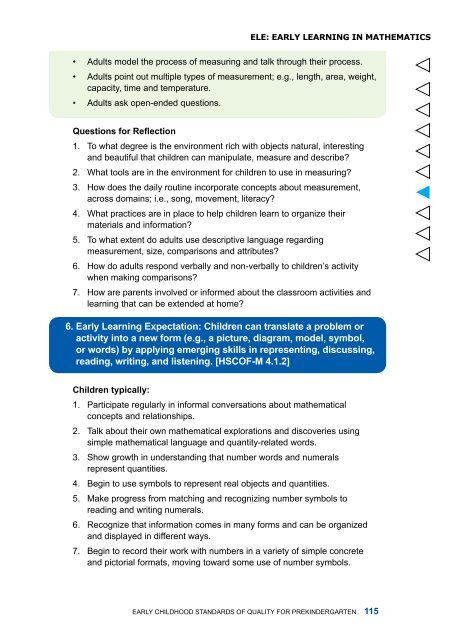Early Childhood Standards of Quality for ... - State of Michigan
Early Childhood Standards of Quality for ... - State of Michigan
Early Childhood Standards of Quality for ... - State of Michigan
Create successful ePaper yourself
Turn your PDF publications into a flip-book with our unique Google optimized e-Paper software.
ELE: early Learning in maTHEMATICS• Adults model the process <strong>of</strong> measuring and talk through their process.• Adults point out multiple types <strong>of</strong> measurement; e.g., length, area, weight,capacity, time and temperature.• Adults ask open-ended questions.Questions <strong>for</strong> Reflection1. To what degree is the environment rich with objects natural, interestingand beautiful that children can manipulate, measure and describe?2. What tools are in the environment <strong>for</strong> children to use in measuring?3. How does the daily routine incorporate concepts about measurement,across domains; i.e., song, movement, literacy?4. What practices are in place to help children learn to organize theirmaterials and in<strong>for</strong>mation?5. To what extent do adults use descriptive language regardingmeasurement, size, comparisons and attributes?6. How do adults respond verbally and non-verbally to children’s activitywhen making comparisons?7. How are parents involved or in<strong>for</strong>med about the classroom activities andlearning that can be extended at home?6. <strong>Early</strong> Learning Expectation: Children can translate a problem oractivity into a new <strong>for</strong>m (e.g., a picture, diagram, model, symbol,or words) by applying emerging skills in representing, discussing,reading, writing, and listening. [HSCOF-M 4.1.2]Children typically:1. Participate regularly in in<strong>for</strong>mal conversations about mathematicalconcepts and relationships.2. Talk about their own mathematical explorations and discoveries usingsimple mathematical language and quantity-related words.3. Show growth in understanding that number words and numeralsrepresent quantities.4. Begin to use symbols to represent real objects and quantities.5. Make progress from matching and recognizing number symbols toreading and writing numerals.6. Recognize that in<strong>for</strong>mation comes in many <strong>for</strong>ms and can be organizedand displayed in different ways.7. Begin to record their work with numbers in a variety <strong>of</strong> simple concreteand pictorial <strong>for</strong>mats, moving toward some use <strong>of</strong> number symbols.<strong>Early</strong> <strong>Childhood</strong> <strong>Standards</strong> <strong>of</strong> <strong>Quality</strong> <strong>for</strong> Prekindergarten 115


